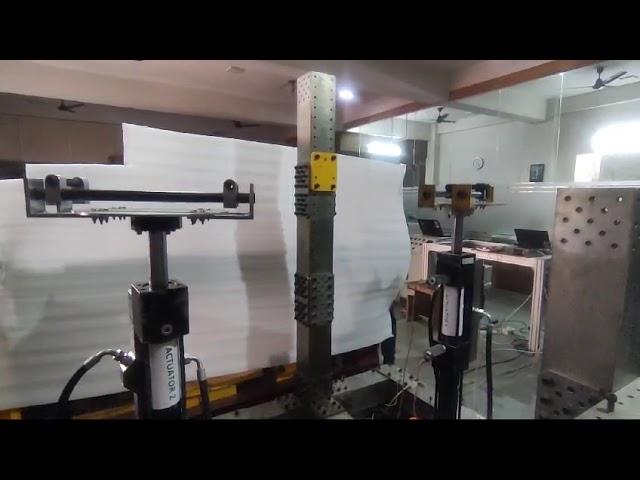
2 Poster Rig - Durability & Vibration Testing
A 2-poster test rig is a specialized setup used for durability and vibration testing of components, particularly in the automotive and aerospace industries. Here’s an overview of how it works and its applications:
Components of a 2-Poster Test Rig
Base Frame: The rig typically consists of a sturdy frame with two vertical posts, providing stability and support for the test specimen.
Actuators: The rig is equipped with hydraulic or electromechanical actuators attached to the frame. These actuators apply forces and create motion.
Test Specimen Mounting: The component being tested is mounted securely between the two posts. This can be a vehicle part, assembly, or other components.
Control System: A control unit manages the operation of the actuators, allowing for programmed loading patterns, vibration profiles, and data acquisition.
Sensors: Various sensors (e.g., accelerometers, strain gauges) are installed on the test specimen to monitor its response to loads and vibrations.
Testing Process
Setup: The component is installed on the rig, ensuring it's properly secured to withstand the applied forces.
Load Application: The actuators are programmed to apply static and dynamic loads. This can simulate real-world operational conditions, including weight, pressure, and stress.
Vibration Testing: The rig can create different vibration profiles. The actuators may oscillate the specimen in various directions, simulating environmental conditions such as road vibrations or flight turbulence.
Data Collection: During the test, sensors collect data on the component’s performance, measuring factors like displacement, stress, fatigue, and failure points.
Analysis: After the testing phase, data is analyzed to evaluate the durability and performance of the component. This information helps identify potential weaknesses and informs design improvements.
Benefits of a 2-Poster Test Rig
Versatility: Capable of conducting a wide range of tests, including static load tests, fatigue tests, and vibration tests.
Realistic Simulation: Replicates the conditions that components will face in real-world applications, ensuring accurate results.
Efficiency: Allows for comprehensive testing in a compact and stable setup, facilitating faster testing cycles.
Data-Driven Insights: Provides valuable data that can enhance component design and ensure reliability and safety.
Overall, the 2-poster test rig is a powerful tool for assessing the durability and vibration resistance of components, helping manufacturers ensure their products can withstand the rigors of real-world use.
A 2-poster test rig is versatile and can be used to test a wide variety of components across different industries. Here are some examples of components that can be effectively tested on this type of rig:
Automotive Components
Suspension Systems: Testing the durability and vibration response of shock absorbers, struts, and springs.
Chassis Components: Evaluating the strength and fatigue life of frame structures and cross members.
Engine Mounts: Assessing the ability of mounts to withstand vibrations and loads.
Drivetrain Components: Testing parts like axles, differentials, and drive shafts under stress.
Aerospace Components
Airframe Structures: Evaluating the durability of wing and fuselage components.
Landing Gear: Assessing load-bearing capabilities and performance under operational conditions.
Control Surfaces: Testing the response of ailerons, rudders, and flaps to dynamic loads.
Industrial Equipment
Robotic Arms: Testing the stress and fatigue of joints and actuators in robotic systems.
Conveyor Components: Evaluating the durability of rollers, belts, and drives.
Heavy Machinery Parts: Testing components such as hydraulic cylinders and gearboxes.
Consumer Products
Appliances: Assessing the durability of parts in washing machines, refrigerators, and other household appliances.
Electronics Enclosures: Testing the vibration resistance of casings and mounting brackets.
Marine Components
Boat Hulls: Evaluating the structural integrity of hulls under varying loads and vibrations.
Propulsion Systems: Testing components such as shafts, propellers, and bearings.
Construction Equipment
Excavator Arms: Assessing the fatigue resistance of hydraulic arms and linkages.
Crane Components: Testing the load-bearing capabilities of booms and supports.
Components of a 2-Poster Test Rig
Base Frame: The rig typically consists of a sturdy frame with two vertical posts, providing stability and support for the test specimen.
Actuators: The rig is equipped with hydraulic or electromechanical actuators attached to the frame. These actuators apply forces and create motion.
Test Specimen Mounting: The component being tested is mounted securely between the two posts. This can be a vehicle part, assembly, or other components.
Control System: A control unit manages the operation of the actuators, allowing for programmed loading patterns, vibration profiles, and data acquisition.
Sensors: Various sensors (e.g., accelerometers, strain gauges) are installed on the test specimen to monitor its response to loads and vibrations.
Testing Process
Setup: The component is installed on the rig, ensuring it's properly secured to withstand the applied forces.
Load Application: The actuators are programmed to apply static and dynamic loads. This can simulate real-world operational conditions, including weight, pressure, and stress.
Vibration Testing: The rig can create different vibration profiles. The actuators may oscillate the specimen in various directions, simulating environmental conditions such as road vibrations or flight turbulence.
Data Collection: During the test, sensors collect data on the component’s performance, measuring factors like displacement, stress, fatigue, and failure points.
Analysis: After the testing phase, data is analyzed to evaluate the durability and performance of the component. This information helps identify potential weaknesses and informs design improvements.
Benefits of a 2-Poster Test Rig
Versatility: Capable of conducting a wide range of tests, including static load tests, fatigue tests, and vibration tests.
Realistic Simulation: Replicates the conditions that components will face in real-world applications, ensuring accurate results.
Efficiency: Allows for comprehensive testing in a compact and stable setup, facilitating faster testing cycles.
Data-Driven Insights: Provides valuable data that can enhance component design and ensure reliability and safety.
Overall, the 2-poster test rig is a powerful tool for assessing the durability and vibration resistance of components, helping manufacturers ensure their products can withstand the rigors of real-world use.
A 2-poster test rig is versatile and can be used to test a wide variety of components across different industries. Here are some examples of components that can be effectively tested on this type of rig:
Automotive Components
Suspension Systems: Testing the durability and vibration response of shock absorbers, struts, and springs.
Chassis Components: Evaluating the strength and fatigue life of frame structures and cross members.
Engine Mounts: Assessing the ability of mounts to withstand vibrations and loads.
Drivetrain Components: Testing parts like axles, differentials, and drive shafts under stress.
Aerospace Components
Airframe Structures: Evaluating the durability of wing and fuselage components.
Landing Gear: Assessing load-bearing capabilities and performance under operational conditions.
Control Surfaces: Testing the response of ailerons, rudders, and flaps to dynamic loads.
Industrial Equipment
Robotic Arms: Testing the stress and fatigue of joints and actuators in robotic systems.
Conveyor Components: Evaluating the durability of rollers, belts, and drives.
Heavy Machinery Parts: Testing components such as hydraulic cylinders and gearboxes.
Consumer Products
Appliances: Assessing the durability of parts in washing machines, refrigerators, and other household appliances.
Electronics Enclosures: Testing the vibration resistance of casings and mounting brackets.
Marine Components
Boat Hulls: Evaluating the structural integrity of hulls under varying loads and vibrations.
Propulsion Systems: Testing components such as shafts, propellers, and bearings.
Construction Equipment
Excavator Arms: Assessing the fatigue resistance of hydraulic arms and linkages.
Crane Components: Testing the load-bearing capabilities of booms and supports.
Тэги:
#Durabalility_Testing #Fatigue_Testing #Vibration_Testing #2_wheeler_testing #Mechanical_Componment #automotive #aerospace #railways #Marione #Construction_Equipment #Consumer_Products #Industrial_Equipment #suspension #chassis #drivetrain #engine_mounts #rubber_mountsКомментарии:
2 Poster Rig - Durability & Vibration Testing
SimTest Dynamics
Great Way To Tie A Noose #nooseknot#knot #knottying
KNOTS FACTORY
..:: Your life purpose ::.. pick a card ..:: timeless tarot ::..
Hazel Lucia Tarot
Андрей и Иван Ургант. Какой у них тип? Альфийский ген. Соционика и наследование типов
Современная Cоционика * Центр Архетип | Socionics
Меховое ателье "Талисман": замена поврежденного меха на шубе.
Ателье Талисман


























